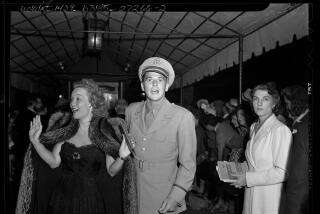To Have and to Hold, Till Divorce Do Us Part
- Share via
With birth, there are blessings. With marriage, there are vows. And with death, there are last rites. But with divorce, there is usually nothing except the coldness of the courts.
Even with modest declines in the divorce rate over the past 10 years, it’s a door roughly 1.2 million Americans walk through each year. Still, it is unique among major life events for having no widely practiced ceremony to mark the time of grief, sorrow and anger. For most, what functions as ceremony is signing a document in a stranger’s office.
A growing number of lay and religious leaders is quietly setting about to correct what they perceive as a glaring omission in the storehouse of America’s rituals. The death of a marriage, and the wrenching passage back to singlehood, not only deserves a ritual, but also cries out for one, they say. And it’s not just New Agers and relationship gurus embracing the concept.
Methodists, Episcopalians, Unitarians, Reform Jews and the United Church of Christ, which has about 1.4 million members nationally, are warming up to the practice. All have officially adopted special prayers or new liturgies to aid couples in coping with the emotional trauma of divorce.
“When we don’t have a ritual to process things, we aren’t as sure how to begin and end things,” said Kay Collier-Slone, the director of Ministries With Single Adults in the Episcopal Diocese of Lexington, Ky. “In the case of divorce, this can translate into getting stuck in a very negative and damaging way of thinking.”
A divorce ritual is meant to be an antidote to the bitter acrimony that characterizes so many breakups. It’s meant to reaffirm, if the marriage produced offspring, the bond between each parent and child. And finally, it’s meant, in the worst of times, to bring out the best in people--tolerance, civility and compassion.
In retrospect, Meg Scherfee credits a 10-minute ceremony at the United Church of Christ with helping to heal family wounds and set the stage for an amicable relationship after she and her husband of 10 years divorced in the ‘90s. As their two children, ages 8 and 4, and a congregation of about 100 watched, Scherfee and her former husband ended their marriage after agreeing to a new set of vows contained in the church’s “An Order for Recognition of the End of Marriage.” Today, both exes have remarried, share custody of their children and belong to the same church.
“It was really the missing piece for us,” said Modesto resident Scherfee, 42, who has had two more children in her second marriage. “It helped relieve a lot of the guilt and shame you feel during a divorce, and it really helped our kids too .... It was extremely beneficial.”
While critics applaud a divorcing couple’s desire to remain on good terms, they contend the ritual tacitly promotes divorce, and thus represents another tear in the social fabric.
“The effort to create a liturgy implies this is a normal passage of life,” said Maggie Gallagher, co-author of “The Case for Marriage” (Doubleday, 2000). “It’s not like death. Divorce is a choice. A choice not to love and all these attempts to pretty it up with a declaration doesn’t change the essence of what’s really going on.”
Divorce ceremonies aren’t more popular, critics say, because there’s no real need for them. If the collected wisdom of the ages failed to produce one until the late 20th century, it’s unlikely such a ceremony is truly fulfilling something deep within the human soul. Rather, it seems more like a fad--and a self-deceptive one at that, they say.
“This is the new magic potion that is supposed to transfer divorce into a friendly, happy occasion and prevent it from harming children? That’s just absurd,” said Gallagher, who is also director of the Marriage Program at the Institute of American Values in New York. “For people who believe a ceremony doesn’t guarantee a marriage will work, they sure have an awful lot of faith in a divorce ceremony.”
It’s not known how many people have actually put their faith in such a ceremony, nor have their been any scholarly studies to measure their effectiveness. Anecdotal evidence suggests the numbers are fairly small. In a busy year, a religious official would perform no more than two or three within a congregation of hundreds.
“I think the reason we haven’t seen more divorce ceremonies is that people see it as celebrating divorce,” said J. Kenneth Davidson Sr., coordinator of family studies at the University of Wisconsin-Eau Claire. “If that perception changes, it wouldn’t surprise me to see lots of people doing it in 20 years.”
There may be more than misperceptions working against a divorce ritual, even assuming that it’s a worthwhile endeavor. Part of what gives a ritual its power is its tradition. Whether it’s a baptism or bar mitzvah, participants in long-established rituals often experience awe and wonder at passing through a gate many others have gone through before them. Divorce ceremonies obviously have no such rich history, and, indeed, its practitioners may have been present at the union’s very creation.
Furthermore, couples that most need such rituals to move on in their lives are the ones least likely to agree to participate in them, the clergy say. Conversely, a couple willing to put the needs of their family and their future relationship above their own anger tend to be the kind of people that can divorce amicably anyway.
One ex-couple that has done as much as anyone to put a positive spin on divorce ceremonies is Phil and Barbara Penningroth, who were married for 25 years. The pair staged their own elaborate divorce event among friends and family in 1997. Their “Ceremony of Parting” included video celebrations of their marriage, readings from T.S. Eliot and a song (“You’re a Part of Me, I’m a Part of You”) from the “Thelma & Louise” soundtrack. The heart of the ceremony featured each partner praising the other for the good in the marriage, asking forgiveness for pain they might have caused, and, finally, blessing and releasing each other to the world.
“The ceremony forces you to drop from a state of anger to one of grief, which feels less powerful,” said Barbara Penningroth, a nurse and family therapist living in Carmel. “It was hard to do because there were a lot of people encouraging me to be a victim or to be angry. I had one lawyer say, ‘I’ll help you get everything he’s got.”’
Phil Penningroth, who initiated the divorce, said it was important for him to rise above his resentments as well. “We’re not saying the bitterness and anger go away immediately. That’s ridiculous,” said the writer, now living in Colorado. “You don’t have to be able to forgive the person right then, but the act of making a public statement to do so at a later point is profound.”
The proceedings proved so powerful that the two, while living in different states, collaborated on a book about the experience. Their efforts resulted in “A Healing Divorce” (1st Books). The book contains dozens of stories from those who’ve gone through divorce ceremonies and offers a number of different ceremonies from which to choose.
“The way divorce in this country is usually handled is slamming a door with a lot of estrangement and bitterness,” said Phil who still painfully recalls his own parents’ divorce when he was a child. “But when you shut the door on the bad stuff, you also shut it on the good stuff--and that’s all part of your life.”
Among the first to offer a divorce ceremony was the Unitarian Universalist Assn., a denomination that boasts founding fathers John Adams and Thomas Jefferson among its past members. Rudolph Nemser, a clergyman for the Boston-based denomination that numbers about 210,000, penned a divorce ceremony in 1966.
“Too often people getting divorced are in the hands of the judicial system and think only of those values, which I think is terrible” said Nemser, who has performed the ceremony about seven times since 1966. “My hope would be the ceremony would change an adversarial relationship to one of cooperation through common interest.”
The United Methodist Church incorporated a 30-line prayer to its official book of worship in 1992. “It’s a healing rite,” emphasizes Dan Benedict, who oversees the church’s liturgy and ritual practices in Nashville, Tenn. “It’s not a reverse marriage.”
Methodist pastors also have the discretion of conducting actual divorce ceremonies, said Benedict, and many across the country have done so. Meanwhile, a formal divorce ceremony may one day be added to their official book of worship, which undergoes a review every 20 years or so.
“We listen to the drumbeat in the church,” said Benedict, whose church has 8.4 million members. “If members are restless and agitating and feel we’re out of tune, then we’ll scramble to test and possibly adopt new forms into our book of worship.”
Building on an ancient orthodox tradition, many rabbis with the Reform Jewish community will perform divorce ceremonies for members. Ceremonies differ but usually call for each partner to write a “get,” or letter, in which the marriage is dissolved but the person agrees to leave behind the pain and anger of the broken relationship. The couple may read or exchange the letters with the rabbi present.
“I encourage couples to do it,” says Rabbi Allen Maller of Temple Akiba in Culver City, who began performing divorce ceremonies some 30 years ago. “I try to get them to realize from the Jewish point of view, divorce is not a sin. It’s a failure; it’s painful, but it’s not a sin.”
Like their Christian counterparts, rabbis will not perform a ceremony unless they think the couple is ready. “I’ve had to turn people away,” said Rabbi David Zaslow of Ashland, Ore. “You can’t do this ceremony if you only have bad things to say. You can’t create sacredness out of bitterness.”
While all these ceremonies may differ in content and character, to succeed they must contain three key elements, according to Pamela Frese, a ritual studies expert. Those include the “rites of separation,” in which things are said and done that remove people from the old way of being (for instance, being in a different dress or place); the “rites of transition,” in which things get reversed or changed, the very function of the ritual (for instance, the exchange of vows or letters); and the “rites of incorporation,” in which people are brought into the new way of being (for instance, a blessing).
“The existence of divorce ceremonies tells us we’re dealing with a society that honors the individual who feels entitled to be divested of all these bad feelings,” said Frese, an expert in life rituals at the College of Wooster in Ohio. “Americans really have the best chance of developing new rituals and customs because we’re not an old country.”
More to Read
Sign up for Essential California
The most important California stories and recommendations in your inbox every morning.
You may occasionally receive promotional content from the Los Angeles Times.













